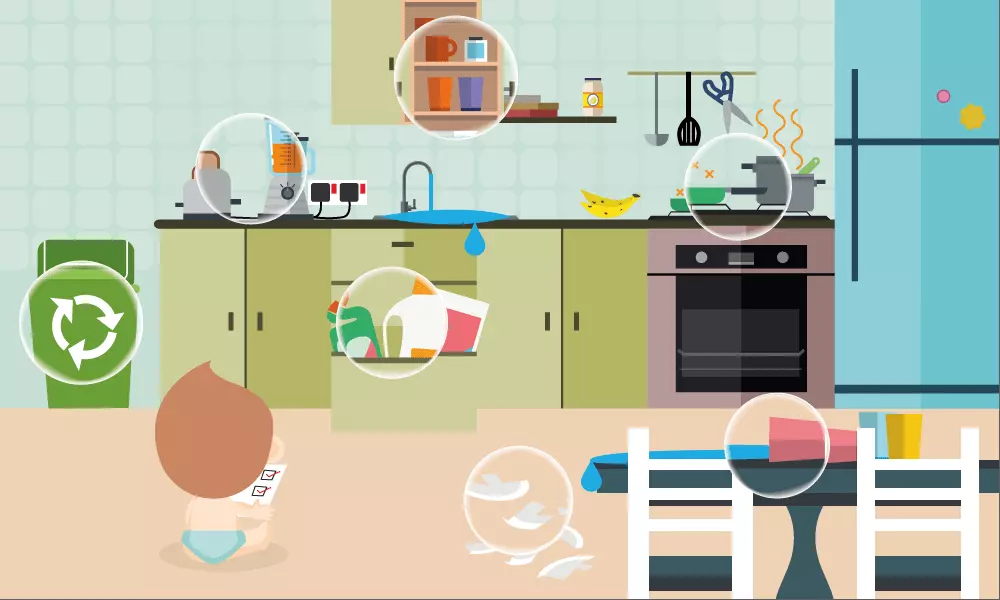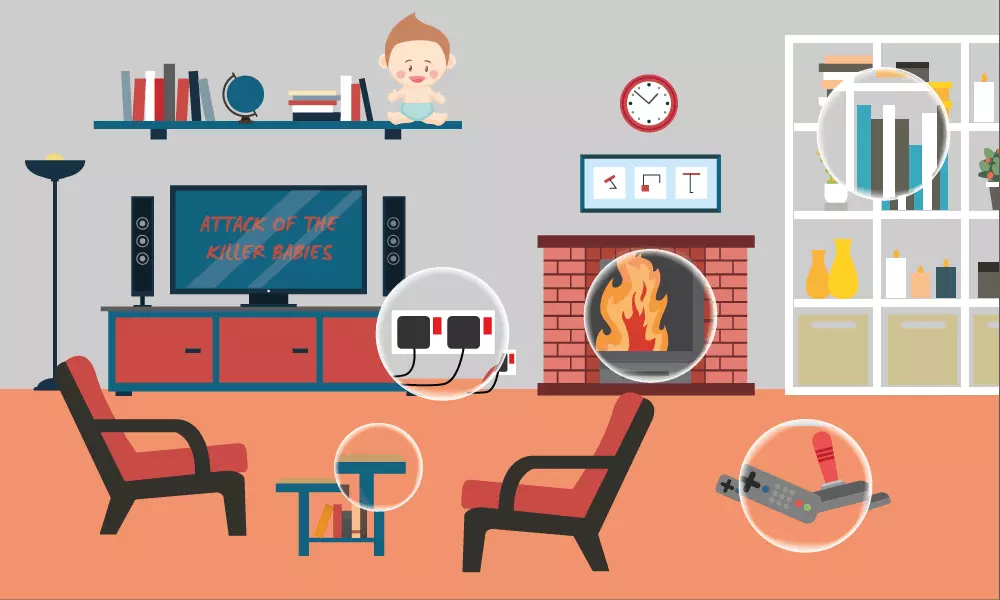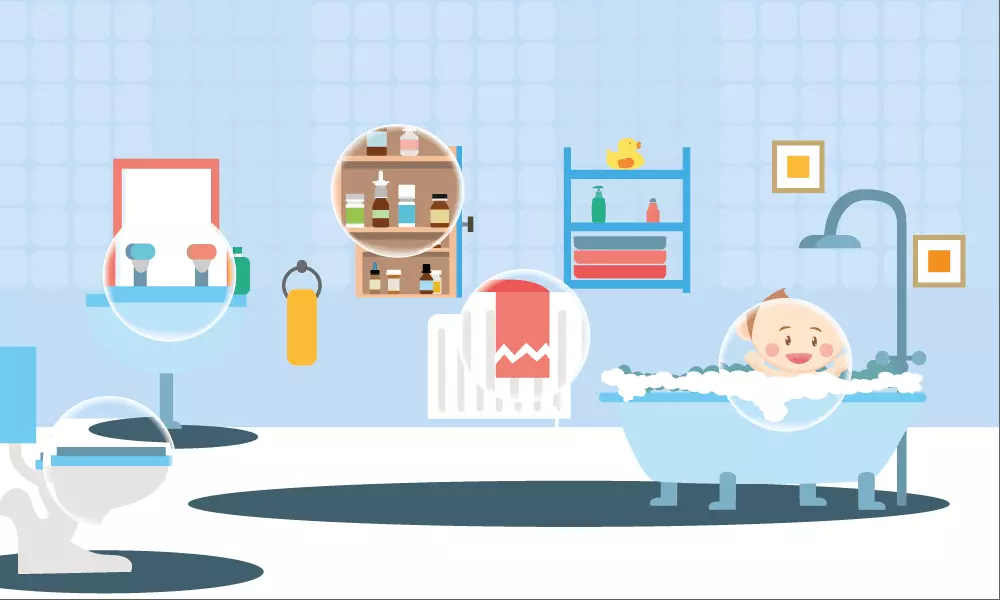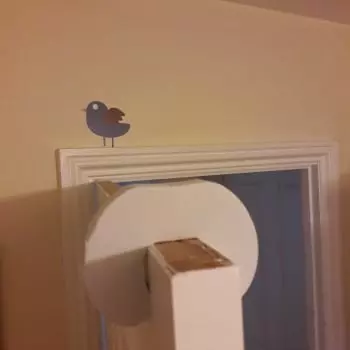The Complete Childproofing Guide
27 September 2016
If a prospective parent is unaware of how much of a life-altering thing having children is, they will soon realise once their baby is delivered. And once that baby can start to move themselves, their home will need to go through a phase of childproofing.
So, how exactly should you approach childproofing your home? The initial answer is with extreme paranoia but that will soon pass. This process doesn’t need to be a stressful course of action, but you do have to reprogram your mind to consider what dangers there are in and around your home for a child - and it’s one that evolves as they become more and more mobile.
Common accidents and injuries
According to the RoSPA, more than 2 million accidents per year, in and around the home, lead to under 15s taking a trip to A&E. The largest number of accidents take place in the living/dining room, whereas the most serious tend to take place in the kitchen or on the stairs, with 44% of all children's accidents being related to falls. Meanwhile, misadventures are statistically more likely for 0-4 year olds, with boys more prone to them than girls.
The nature of injuries can be quite wide-ranging, but can generally be categorised within the following areas:
Falls
Scalds & Burns
Glass-related
Poisoning
Suffocating & Choking
Strangulation & Blind Cords
Drowning
Brain Development
When it comes to mammals, humans have the most vulnerable babies beyond the point of birth. They are completely dependent upon their parents/carers and are born with relatively underdeveloped brains.
This is no bad thing; humans have positioned themselves at the top of the food chain after all, and unconditional support is one of the things you sign up to when you have children. Plus there's a belief that our comparatively slow brain development is what enables us to surpass all other species, as it allows human babies time to absorb their surrounding culture.
Realising this helps to engender the cautious mindset that parents need, and to consider the vulnerable perspective of their child. They will become increasingly inquisitive but will also be unaware of surrounding hazards until they learn to know better. A good way to approach childproofing and to make it all less daunting is to systematically consider what needs to be done to make each room of your house a safe environment. Here are some pointers on what to look out for.
Kitchen

- When your baby begins to actively crawl around, you’ll probably find them gaining satisfaction from endlessly opening drawers and cupboards. As a result, these will need securing first - because if it can be opened, then little ones can trap fingers and pull out whatever’s tucked away inside. There are plenty of locks available to counteract the curiosity of a child, from safety catches that fit inside a drawer, to sticky tabs and the more expensive magnetic catches. The best advice is to read up on reviews from other parents to find what is most durable and effective.

- In the kitchen you’re bound to have several cleaning products and items of electrical equipment. Needless to say all of this needs to be kept well out of the way. The same goes for plastic bags, cardboard and any glass or tins. Ultimately use your common sense, if it can be broken/eaten/suffocating then be sure to have it out of reach.
- Hot pans and drinks are a common source of danger in the kitchen, and as your child grows you’ll have to adapt your habits. For example, once they are practicing their standing, they’ll suddenly be able to dramatically increase their reach. Start using the hobs at the back of your cooker and never leave drinks near the edge of your work surfaces.
- Spillages and breakages will occasionally happen when you’re cooking. Needless to say, these are gateways to falls and other potentially serious mishaps. Therefore, the best way to avoid any issues is to immediately and thoroughly clean them up.
- Finally, you have other utilities and furniture to keep an eye on. There will come a time when ovens, dishwashers, fridge freezers and washing machines all become accessible and further locks are required. Chairs can represent a tempting climbing frame too, so be sure to tuck them away to lessen their appeal.
Living Room

This is the part of your home that will probably contain the most risks, largely due to furnishings and furniture. Consideration must be given to things that were never before on your radar, for example remote controls (when chewed upon, their buttons can lead to a choking hazard).
- With that in mind, you’ll have to view each piece of furniture with suspicion. The truth is that your child will eventually see your bookcase as a heavily disguised ladder. Any furniture that could be pulled over must therefore be secured, and there are several varieties of straps and brackets that can do the job.
- Now that your furniture is not going to topple over, you should make sure that the accessible edges aren’t going to present a hard surface to fall head first into. As babies start to get more confident and develop their skills at manoeuvring, they also have a phase where they tumble and fall. Learning about balance can be hard! To counter this there are different corner protectors and sticky edge cushions available.
- If your TV is not attached to a wall, then it too will become accessible one day. However, as with your furniture, there are straps you can buy that are specifically designed to keep your TV intact and upright. Wiring in general should be kept under control, with cable ties or tubes a good option for minimising trips etc.
- If you happen to have a fireplace within your living room, then clearly these can present a serious danger, either due to heat or a hard surface. Depending on what you need there is lots out there to help, ranging from edge guards, soft furnished covers and gates/complete guards.
Bathroom

It’s fair to say that for their first few years, your child is unlikely to be unsupervised in the bathroom. During bath time in particular you should always be present, as a toddler only needs 3cm of water to drown.
- The temperature of the bath water should be approximately 37 °C, and you can keep track of this with some effective baby thermometers. With regards to water depth, for newborns and up to 6 months old you want the water to cover their shoulders as they are unable to regulate their own body temperature at this stage. You can also use bath seats to make it easier to support them, but never rely on it as a tool to prevent drowning.
For older children the water does not need to be more than waist high (sitting down), but you should consider a rubber non-slip bath mat to avoid falls.
- If you find it to be something that you need, you can even get hold of soft or inflatable style covers for your taps. There are some fun designs around that will reduce the impact of a fall or a still hot tap.
- Being the bathroom, you’re bound to have cleaning chemicals. Not just the ones that keep you smelling fresh, but also those that keep the room hospitable! All of these need to be kept out of the reach of curious little hands, so whether this means shelving, bathroom cabinets or cupboards, you know what to do. The same applies for medicines etc. and don’t forget locks for any doors. Be mindful of radiators and towel rails which can easily cause burns, with some research it is possible to cover these up professionally, or you should at least use a towel itself. As for the toilet, you can prevent any unhygienic touching and the depositing of your mobile phone with a further lock.
Nursery/Bedroom

Even though this room will act as a personal sanctuary for your child, it should - in theory - be the easiest room to make safe. This is the part of your home that is being specifically set up for your little one, whereas the remainder of it is being adapted to fit this need.
You should note in this section the important advice on buying cots and avoiding Sudden Infant Death Syndrome (SIDS).
- When it comes to moving your baby into their own room for the first time, you really want to have everything in place. The first thing to consider is their sleeping arrangements; it’s advised that you don’t place a cot near a window, which is once again due to babies having an inability to regulate their own temperature at a young age. For the same reasoning you should keep the cot away from radiators.
As your child grows, it is still best to keep your furniture away from the window so they aren’t encouraged to climb up onto window sills.
- If you intend to have cupboards and drawers in this room, then obviously the same rules apply as before with regards to the need for locks. Personally I avoided these and went with storage that was high up on the wall - and therefore out of reach for years to come.
- It’s a good idea to have your changing table well-stocked with everything that you need at all times, and with one side against a wall. Your baby will at some stage learn to roll over and you’ll want to be focused when changing them, and to avoid a nasty drop.
- Doors can pose a danger to small fingers too. You can purchase finger guards which will prevent
 them being trapped in the space between the hinged edge and the door frame. Alternatively, there are foam guards that slot over the top of the door and act as a buffer when it closes.
them being trapped in the space between the hinged edge and the door frame. Alternatively, there are foam guards that slot over the top of the door and act as a buffer when it closes.
- Baby monitors and window blinds with cords, can both lead to incidents of strangulation. To avoid such tragic circumstances, these types of monitors should be positioned so that they cannot be grabbed from a cot, and then tidied away when your child is roaming free in their nursery.
With regards to blinds with cords, European laws introduced in 2014 have made it illegal for these products to be sold unless they are fixed to the wall or include a snap-mechanism. On top of this, use your common sense and make sure that cords are positioned out of harm’s way.
Garden

Your garden should offer a safe space for your little one to explore and discover more about the world around them, but just like the inside of your home you’ll have to make sure it’s suitably safe.
- Babies & small toddlers are curious, and one of the ways that they begin to find out about things is by sticking it in their mouth. This is why small objects should be kept away, and why in the garden you’ll want to be aware of what plants could be harmful.
- If your garden contains a pond or water feature, then this should be securely fenced off or covered to make it safe. If this isn’t an option, then the best course of action is to remove it.
- Be sure to keep any chemicals or tools you have securely locked away - and when it comes to having BBQs or doing DIY, your child should be well supervised.
- Finally, it’s easy to forget that children have more vulnerable skin when they are out in the sun. Always take care to use sun cream that will sufficiently protect them from the rays as they play.
Other Safety Information
Stairs
As mentioned before, some of the most serious accidents for young children occur on the stairs. For their safety (and yours), this part of the house should be free from toys and clutter.
A stair gate is also a must, and depending on the design of your home, you’ll probably need one at the top and bottom of the stairs. Mothercare often offer discount codes on baby products, including stair gates.
It's also key to check that your carpet and bannister are securely fastened and fitted into place.
Plug Sockets
In the past it has been recommended to cover up your numerous plug sockets, but normal household sockets in the UK are considered safe and there are now debates on how socket covers could actually increase the risk of electrocution.
Windows
When the time comes that your child is old enough to get to the window, you’ll want to ensure that they cannot then open them. The easiest option is to have lockable windows that only an adult has the key for. But there are also many guards, stops and locks that you can add if you do your research.
First Aid
In case you are ever in the situation when you need to deal with an emergency situation, you’ll want to know the correct techniques to respond. There are first aid courses available from St John Ambulance, Red Cross & NCT to name just a few.
Summary
Naturally you will always worry about the welfare of your child, especially when they are young and vulnerable. But with the help of this guide, you should have a much clearer understanding of what’s needed to make your home a safe haven. The more children grow, the more their curiosity will aid them in learning about the wider world, all parents have to do is protect them from getting too many injuries as they do it!